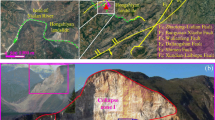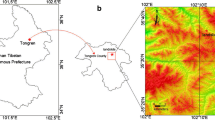Abstract
This paper presents a preliminary study of time evolution and spatial accumulation of progressive failure for ancient landslide deposits in Xinhua slope. According to the geological response after impoundment, the Xinhua slope has shown the spatial accumulation of deformation, such as ground cracks in the rear edge, toe collapse, local shallow slides in intense rainfall, and progressive creep displacement. Approximately 2 years of monitoring was performed for the Xinhua slope with the assistance of the global navigation satellite system (GNSS), unmanned aerial vehicles (UAVs), and field investigations. The deformation process of a reservoir landslide is considered to be a comprehensive and complicated combination of geological influence from various adverse factors. Field investigations and monitoring indicate that the major serious influence after completion of dam construction comes from the initial large-scale impoundment, the fluctuation of water level, and the existence of a flood season. The creep/slip deformation of slope deposits is a result of integration with adverse hydraulic conditions, e.g., strong rainfall, intense currents and transient seepage flow inside the slope deposits, and activation by water level fluctuation, which can be verified from the twofold evident deformation in the flood season. For the reservoir with daily regulation ability, the occurrence of evident deformations in July highlights that the regulation plan for water level in the flood season is important for controlling the deformation of slope deposits, where the fluctuation of the water level is no more than 10 m in the operation period.












Similar content being viewed by others
References
Bansal RK, Das SK (2011) Response of an unconfined sloping aquifer to constant recharge and seepage from the stream of varying water level. Water Resour Manag 25(3):893–911. https://doi.org/10.1007/s11269-010-9732-7
Berilgen MM (2007) Investigation of stability of slopes under drawdown conditions. Comput Geotech 34(2):81–91. https://doi.org/10.1016/j.compgeo.2006.10.004
Biagi L, Grec FC, Negretti M (2016) Low-cost GNSS receivers for local monitoring: experimental simulation, and analysis of displacements. Sensors 16(12):2140. https://doi.org/10.3390/s16122140
Bjerrum L (1967) Progressive failure in slope of overconsolidated plastic clay and clay shales. Terzaghi Lect 2:77–78
Casagli N, Frodella W, Morelli S, Tofani V, Ciampalini A, Intrieri E, Raspini F, Rossi G, Tanteri L, Lu P (2017a) Spaceborne, UAV and ground-based remote sensing techniques for landslide mapping, monitoring and early warning. Geoenvironmental Disasters 4:1–23. https://doi.org/10.1186/s40677-017-0073-1
Casagli N, Tofani V, Morelli S, Frodella W, Ciampalini A, Raspini F, Intrieri E (2017b) Remote sensing techniques in landslide mapping and monitoring, keynote lecture. In: Mikoš M, Arbanas Ž, Yin Y, Sassa K (eds) Advancing culture of living with landslides, vol. 3—advances in landslide technology. Springer International Publishing, Switzerland, pp 1–19
Chelli A, Mandrone G, Truffelli G (2006) Field investigations and monitoring as tools for modelling the Rossena castle landslide (Northern Appennines, Italy). Landslides 3(3):252–259. https://doi.org/10.1007/s10346-006-0046-z
Duc DM (2013) Rainfall-triggered large landslides on 15 December 2005 in Van Canh District, Binh Dinh Province, Vietnam. Landslides 10(2):219–230. https://doi.org/10.1007/s10346-012-0362-4
Dufresne A, Prager C, Clague JJ (2015) Complex interactions of rock avalanche emplacement with fluvial sediments: field structures at the Tschirgant deposit, Austria. In: Lollino G, Giordan D, Crosta GB, Corominas J, Azzam R, Wasowski J, Sciarra N (Eds) Engineering geology for society and territory—vol. 2, Springer International Publishing, pp. 1707–1711. doi: https://doi.org/10.1007/978-3-319-09057-3_303
Fan L, Zhang G, Li B, Tang H (2017) Deformation and failure of the Xiaochatou landslide under rapid drawdown of the reservoir water level based on centrifuge tests. Bull Eng Geol Environ 76(3):891–900. https://doi.org/10.1007/s10064-016-0895-1
Huang BL, Zheng WJ, ZZ Y, Liu GN (2015) A successful case of emergency landslide response—the Sept. 2, 2014, Shanshucao landslide, Three Gorges Reservoir, China. Geoenvironmental Disasters 2(1):18. https://doi.org/10.1186/s40677-015-0026-5
Hungr O, Leroueil S, Picarelli L (2014) The Varnes classification of landslide types, an update. Landslides 11(2):167–194. https://doi.org/10.1007/s10346-013-0436-y
Iverson RM (2000) Landslide triggering by rain infiltration. Water Resour Res 36(7):1897–1910. https://doi.org/10.1029/2000WR900090
Ji F, Shi YC, Liu HC, Deng ZW (2005) Study on formation mechanism and stability of ancient Xinhua landslide in Daduhe River. Hydrogeol Eng Geol 32:24–27 (in Chinese)
Okeke CU, Wang F (2016) Critical hydraulic gradients for seepage-induced failure of landslide dams. Geoenvironmental Disasters 3(1):9. https://doi.org/10.1186/s40677-016-0043-z
Panizzo A, De Girolamo P, Di Risio M, Maistri A, Petaccia A (2005) Great landslide events in Italian artificial reservoirs. Nat Hazards Earth Syst Sci 5(5):733–740. https://doi.org/10.5194/nhess-5-733-2005
Saito Y, Yang Z, Hori K (2001) The Huanghe (Yellow River) and Changjiang (Yangtze River) deltas: a review on their characteristics, evolution and sediment discharge during the Holocene. Geomorphology 41(2-3):219–231. https://doi.org/10.1016/S0169-555X(01)00118-0
Schwab JW, Geertsema M, Blais-Stevens A (2004) The Khyex River landslide of November 28, 2003, Prince Rupert British Columbia. Canada Landslides 1(3):243–246. https://doi.org/10.1007/s10346-004-0026-0
Semenza E, Ghirotti M (2000) History of the 1963 Vaiont slide: the importance of geological factors. Bull Eng Geol Environ 59(2):87–97. https://doi.org/10.1007/s100640000067
Shi J, Hua B, Chen X, Jun LI (2015) Design of GNSS automatic monitoring network of Xinhua landslide in Dagangshan reservoir area. Yangtze River 46:53–56 (in Chinese)
Tiwari B, Lewis A (2014) Experimental modelling of seepage in a sandy slope. In: Sassa K, Canuti P, Yin Y (Eds) Landslide science for a safer geoenvironment, Springer, pp 109–115. https://doi.org/10.1007/978-3-319-05050-8_18
Tu GX, Deng H, Huang RQ (2011) Influence on a bank slope accumulations’ stability of the rising or falling speed of a reservoir water level. J Sichuan Univ 42:63–70 (in Chinese)
Vandamme J, Zou QP (2013) Investigation of slope instability induced by seepage and erosion by a particle method. Comput Geotech 48:9–20. https://doi.org/10.1016/j.compgeo.2012.09.009
Wang F, Li T (2009) Landslide disaster mitigation in Three Gorges Reservoir, China. Mt Res Dev 30:184–185
Wang F, Miyajima M, Li T, Shan W, Fathani TF (2013) Progress of geo-disaster mitigation technology in Asia. Environ Sci Eng 1:565–582
Xia M, Ren GM, Ma XL (2013) Deformation and mechanism of landslide influenced by the effects of reservoir water and rainfall, Three Gorges, China. Nat Hazards 68(2):467–482. https://doi.org/10.1007/s11069-013-0634-x
Xia M, Ren GM, Zhu SS, Ma XL (2015) Relationship between landslide stability and reservoir water level variation. Bull Eng Geol Environ 74(3):909–917. https://doi.org/10.1007/s10064-014-0654-0
Yamada M, Ichikawa K, Kuwano T, Takeuchi T, Nakagawa A (2013) The interpretation for landslide mechanism and the proposal of landslide countermeasures in Abay Gorge in Ethiopia. In: Ugai K, Yagi H, Wakai A (Eds) Earthquake-induced landslides, Springer Berlin Heidelberg, pp. 405–406. doi: https://doi.org/10.1007/978-3-642-32238-9_42
Yang H, Wang F (2014) Influence of water level drawdown on landslide movement in reservoir. In: Sassa K, Canuti P, Yin Y (Eds) Landslide science for a safer Geoenvironment, Springer, pp. 703–708. doi: https://doi.org/10.1007/978-3-319-04996-0_106
Zhao Y, Xu M, Guo J, Zhang Q, Zhao H, Kang X, Xia Q (2015) Accumulation characteristics, mechanism, and identification of an ancient translational landslide in China. Landslides 12:1–12. https://doi.org/10.1007/s10346-014-0535-4
Zhou JW, Xu WY, Yang XG, Shi C, Yang ZH (2010) The 28 October 1996 landslide and analysis of the stability of the current Huashiban slope at the Liangjiaren hydropower station, Southwest China. Eng Geol 114(1-2):45–56. https://doi.org/10.1016/j.enggeo.2010.04.001
Zhou JW, Xu FG, Yang XG, Yang YC, Lu PY (2016) Comprehensive analyses of the initiation and landslide-generated wave processes of the 24 June 2015 Hongyanzi landslide at the Three Gorges Reservoir, China. Landslides 13(3):589–601. https://doi.org/10.1007/s10346-016-0704-8
Zhou JW, Lu PY, Yang YC (2017) Reservoir landslides and its hazard effects for the hydropower station: a case study. In: Mikoš M, Arbanas Ž, Yin Y, Sassa K (eds) Advancing culture of living with landslides, vol. 2—advances in landslide science. Springer International Publishing, Switzerland, pp 699–706
Acknowledgements
Critical comments by the anonymous reviewers greatly improved the initial manuscript.
Funding
We gratefully acknowledge the support of the National Natural Science Foundation of China (41472272) and the Youth Science and Technology Fund of Sichuan Province (2016JQ0011).
Author information
Authors and Affiliations
Corresponding author
Rights and permissions
About this article
Cite this article
Chen, Ml., Lv, Pf., Zhang, Sl. et al. Time evolution and spatial accumulation of progressive failure for Xinhua slope in the Dagangshan reservoir, Southwest China. Landslides 15, 565–580 (2018). https://doi.org/10.1007/s10346-018-0946-8
Received:
Accepted:
Published:
Issue Date:
DOI: https://doi.org/10.1007/s10346-018-0946-8




